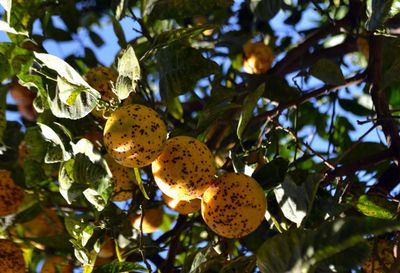Diseases in Orange Trees
There are several common diseases that can impact citrus trees and that are caused by fungi, bacteria, or pests. Keep a close eye on your trees and look for the characteristic signs that you have sick orange trees. When you know the symptoms you can quickly diagnose and manage a particular disease.
Greasy spot – Greasy spot is fungal infection that causes dark, greasy-looking spots on leaves, leaf drop, and reduced tree vigor. Fruits may have black specks.
Citrus scab – Warty-looking scabs appear on fruit, twigs, and leaves of trees affected with scab. Look for conical growths on leaves first.
Citrus canker – This disease affects all citrus and is caused by bacteria. Look for lesions of dead tissue on leaves, surrounded by yellow and dark brown lesions on fruit. Severe infection causes dieback, defoliation, and early fruit drop.
Melanose – Melanose causes raised, rough brown lesions on leaves and streaking patterns on the fruit.
Root rot – Both armillaria and phytophthora can cause citrus root rot. Above ground, look for wilting of leaves and a thin canopy for the former and yellowing leaves for the latter. In each case, look at the roots for signs of rot and disease.
Citrus greening – Yellowing leaves can be a nutritional deficiency, but it can also be caused by the destructive citrus greening disease. Look for yellowing patterns, small upright leaves, leaf drop, and dieback. Fruits will be small and uneven with a bitter taste.
Sooty canker or mold – Both sooty canker disease and sooty mold can lead to limb dieback. The bark peels away, revealing a sooty black fungus.
Stubborn disease – Likely caused by a virus, there is no known control for citrus stubborn disease. It causes fruit to grow small and lopsided. Leaves are small and tree growth stunted.
Treating Orange Tree Diseases
Knowing how to treat a diseased orange tree depends on diagnosis. If you aren’t sure what is affecting your tree, contact your local extension office for information and assistance. Some of these diseases can be treated, while others require that you remove the tree and start over again. Prevention is always best, which means being aware of diseases in your local area. Provide your orange trees with the best possible conditions because trees that are healthy and vigorous are less susceptible to disease. Especially important is providing enough water but ensuring good drainage too. Practice good hygiene to prevent spread of disease by cleaning up debris regularly and disinfecting pruning shears and other equipment.
